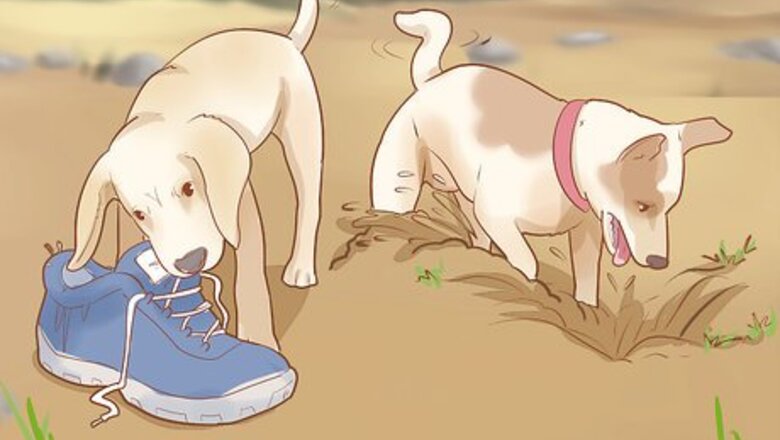
views
Understanding Your Dog’s Destructive Behavior
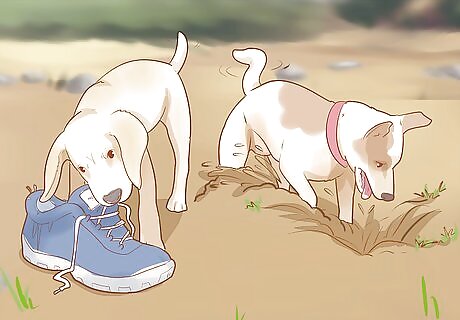
Understand what can constitute destructive behavior in dogs. Dogs love to chew on stuff. While puppies can be destructive, their destructive play is more about exploring and testing their boundaries than about intentionally destroying things. On the other hand, a destructive adult dog displaying negative behavior such as chewing, digging holes in the backyard, or chewing up the shrubbery needs attending to.
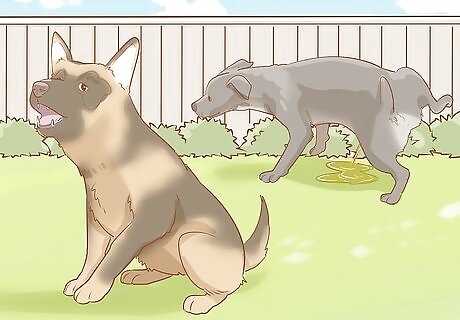
Figure out if you dog exhibits attention-seeking behavior. Does your dog bark constantly, chew on furniture, or urinate on the ground to get attention? We often reward this behavior by simply directing our attention towards the negative behavior, thereby reinforcing the dog's attention-seeking behavior. If this is the case, you’ll need to reprogram your dog’s expectations. You’ll need to give them more attention in general. Only give your dog attention when they are behaving positively.
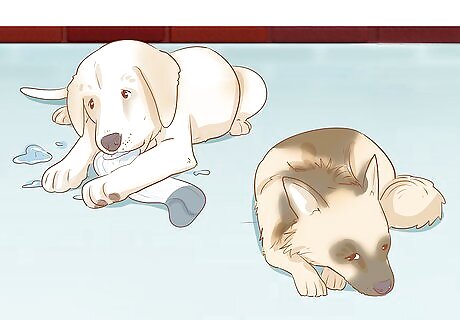
Identify separation anxiety. One of the best things about having a dog is the bond your create. Sometimes, this bond is so strong that your little furry friend might not know how to be independent. About 10% of all puppies and older dogs experience some level of separation anxiety. In the more extreme cases, a dog will throw a tantrum and start barking, pacing, defecating in inappropriate places, and destroying walls or doors in an attempt to get back to an owner.
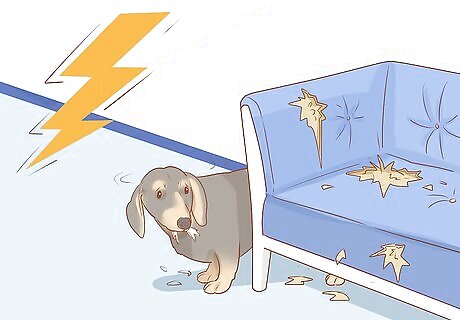
See if your dog is afraid of loud noises. Your dog might respond with fear to such loud noises as thunder or fireworks by destroying doors, walls, or objects, in order to try to hide. Figure out your dog’s logic. It is trying to seem threatening to the unknown element that is making so much noise.
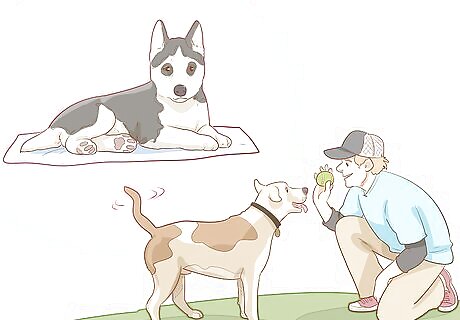
Determine if your dog is simply bored. Do you keep your dog locked in a white-washed, empty room all day? Are they forced to just sit in their cell without any form of exercise or stimulation? If so, your dog might resort to destructive behavior simply to entertain themselves. Give them store-bought or homemade toys to play with while you are gone. Give them a blanket to lay on. Relocate them to different areas to let them explore. In short, give them things to do in order to stop their boredom. You’d hate being in their place otherwise.
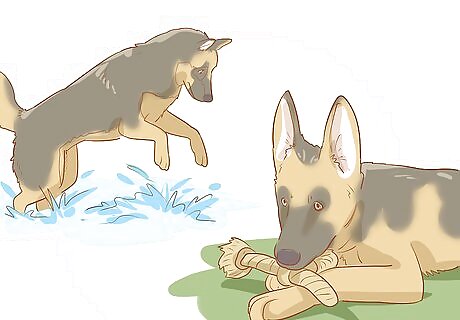
Identify over-activity or hyperactivity. Is your dog always full of energy and always active? Does your dog constantly chew on things, run in circles, bark, and wreak havoc? Hyperactivity is simply a matter of perception. Most experts insist that hyperactivity is rare in dogs. Most likely, your dog just needs more attention and exercise. Vets only diagnose a dog with hyperactivity if they have eliminated all other possibilities.
Burning Up Your Dog’s Excess Energy
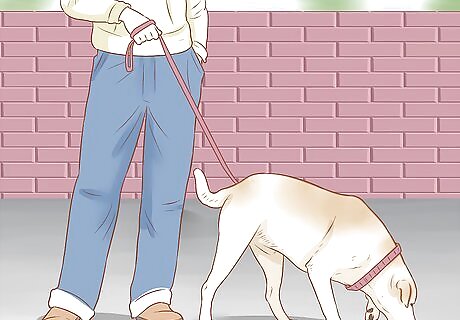
Walk your dog regularly. While this may not seem like an answer for a destructive dog, it is important to first address the basics and ensure your dog's needs for mental stimulation and physical activity are met. If you have slipped in maintaining a walking routine with your dog, reinstate it. If you haven't yet developed a routine, start now. And if you're not free to walk your dog regularly, find somebody who can. Go for regular walks and try to include a variety of exercise options during the walk. Some ideas include: Buy a leash that is only a few feet long. The closer your dog is when he walks with you, the more he'll know that you’re the one who has the authority and is in control. Never let him walk behind you or ahead of you, but always right by your side. This lets him know you’re in authority and he must submit. Take your dog on a walk in an area that is challenging. Try anywhere that has hills or an incline. Allow him to take breaks once in awhile and bring along water for him to drink as needed. Your dog may get in the habit of using the same trail, so switch it up to challenge him and keep him from getting bored. Visit a beach that allows dogs. The sand is excellent exercise for the dog's muscles, and the sea offers a fabulous opportunity for swimming and fetching all manner of items you can toss to your dog. If you don't want to take a ball, use the beach flotsam to play fetch with your pooch. Vary the parks you're visiting to walk your dog. Find out which parks allow dogs and vary your schedule each week to visit different ones. This will be stimulating for both of you, as you see new sights and explore new places.
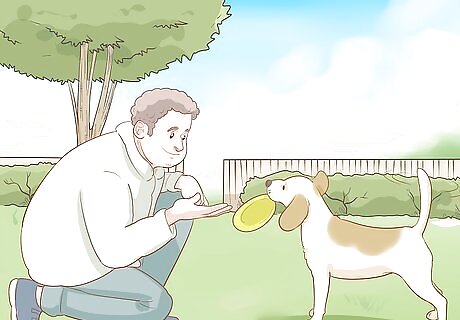
Play with your dog more. Besides walking, play is an important part of your dog's interaction with you. Play catch in the backyard for 15 minutes a day. Try doing this in the morning when you're more alert and your dog is usually very hyper. You’ll notice that he'll have less energy throughout the day if you drain him of it earlier on. Make a meet-up time for doggy friends. Find out which of your friends own dogs and plan meet-ups in central locations where your dogs can play together. Naturally, you'll also need to learn in advance if they get along with each other. Buy a frisbee and help your dog become used to it. Once he is aware of what a Frisbee is for, let him join in the fun.
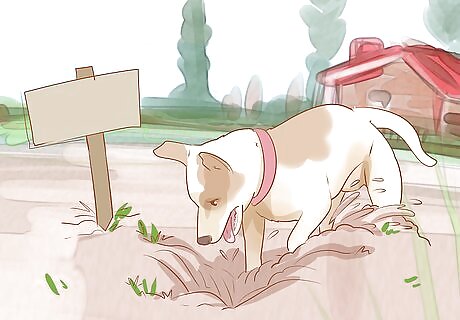
Give your dog some digging space. If you can't beat it, join it but at least direct it to where your dog can dig without destroying your garden. Create the space, till it over, and bury some goodies in it that it’ll love finding. Burying items close to the surface at first. Then gradually bury them deeper. This can help retain her interest in the new digging spot. It also helps if you can temporarily block off her old digging space. If your dog is digging because she is bored, increase the play and exercise activities. Don't leave her alone in the yard all day. If your dog is digging because she appears to making herself a nice, cool, soft place to sleep on, create a shaded area for her, with something comfortable and cool to lie on.
Enriching Your Dog's Environment
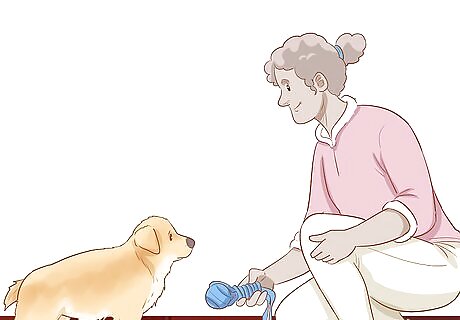
Leave your dog with the right toys while you’re away. The most common time of the day that your dog is likely to be destructive is when you’re away at work or out doing things away from the house. Your dog can feel lonely, isolated, or unloved. Be sure to affirm your dog before leaving by giving him plenty of attention, playing a game of catch, or taking him on a walk. Dogs tend not to play with toys without the owner there. Leave the dog a Kong, or a chew toy stuffed with food, so that it gets his attention. You could also give the dog a cardboard box with a chew toy inside, so he has to chew his way into the toy.
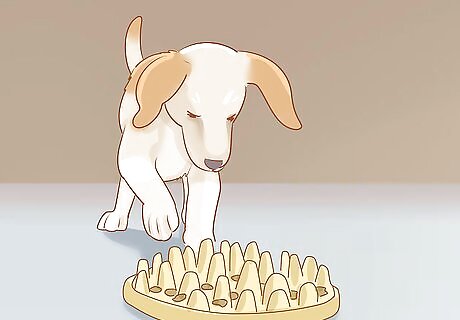
Try puzzle feeders to mentally stimulate your dog. Your dog needs mental as well as physical stimulation, and puzzle feeders are a great way to accomplish this. There are tons of toys on the market that encourage dogs to use their brains to unlock hidden treats, but you can also make a puzzle feeder at home. Put treats in an empty muffin tin and then place tennis balls on top. Your dog must figure out how to get the balls out of the way so he can access the treats. This is a good beginner game, and you can work up to more difficult puzzles, such as those with sliding pieces. You can also play games that will keep your dog mentally stimulated, such as hiding toys or treats around the house or in cardboard boxes.
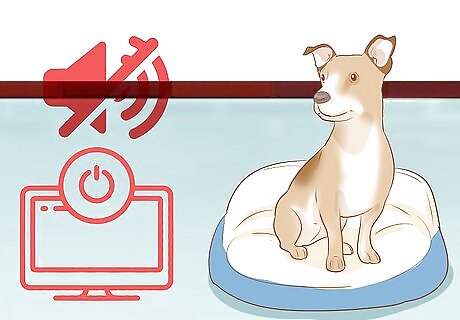
Provide your dog with the right environment. Notice if your dog seems to get more wound up when there is a lot of stimulation, such as the television being on or sounds from another room. If this seems to be the case, turn the television down lower and close any doors where sound can impact her negatively. However, if she seems to like the sound and even seems comforted by it, consider leaving the radio or television on while you are gone at work. This might help with your dog’s separation anxiety.
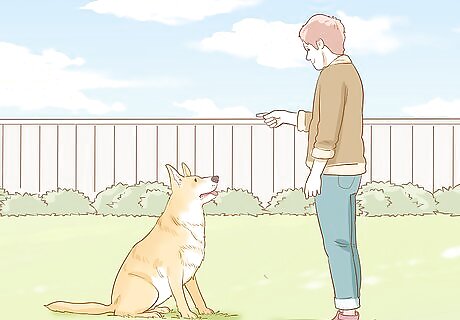
Train your dog. Training your dog to "Sit," "Come," "Lay," "Wait," and so on not only teaches him good manners, it also provides great mental stimulation. Try an obedience class to help you teach him the basics and work on training in short sessions every day. If your dog already knows the basics, step up your training with more challenging tricks, like rolling over or playing dead.
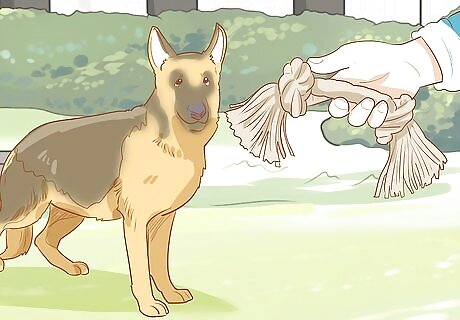
Rotate toys. Don’t always have the same old toys out. Dogs will tire of a new toy very quickly. Make sure you hide all of his toys in a closet and only allow two or three to be out at a time. When you switch the toys around, your dog will be entertained more and he'll think it’s a treat when he gets an old toy to play with that’s been hidden away. As an added incentive, this will prevent you from spending more money on new toys.
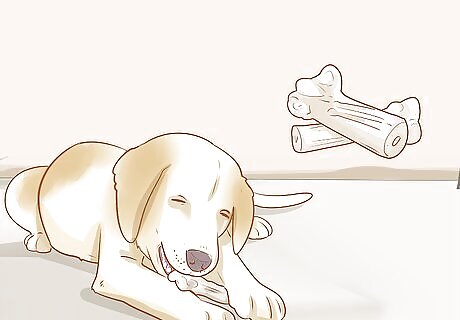
Give your dog chew sticks. This will stop them from chewing on other things. Chew toys made of rawhide and other organic matter are not intended to be durable or permanent. Pieces of these toys chip off; the size of the pieces can vary depending upon your dog’s size and enthusiasm. Such pieces can be sharp and can cause serious damage to your dog’s mouth, throat, and digestive tract. Never give rawhide chews to an unsupervised dog, as the may choke. Don't leave the chew toy laying out all the time. Take it away when not needed so the dog doesn't become bored with it.
Giving Your Dog A Peaceful Environment
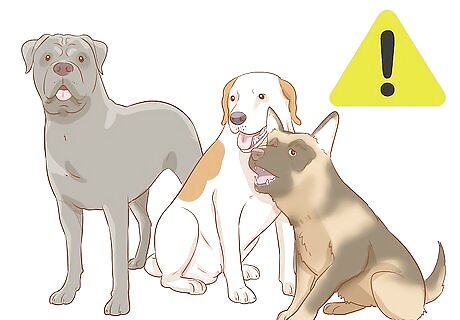
Avoid overcrowding your dog. If your dog feels overcrowded, either by living in a confined space or being forced to share his space with other dogs without having space of his own, abnormal behaviors can arise. In particular, male dogs will fight over territory if they feel crowded.
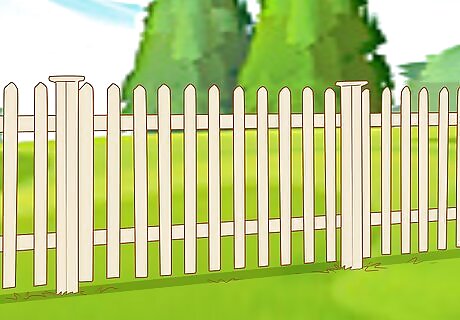
Ensure that your dog is fenced in well. Poor fencing that allows your dog to slip out can result in destructive behaviors including car chasing, fighting with other dogs, and potentially attacking people. In many jurisdictions, you are required by law to ensure that your dog is properly restrained and you'll be held liable for your dog's bad behavior.
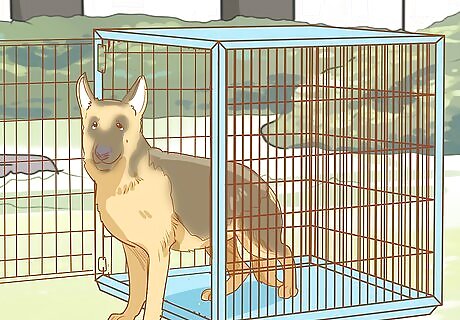
Get your dog a kennel and use it properly. Get a kennel for your dog to use when you're not home, and to sleep in. To get your dog used to his "safe space", put him in it throughout the day while you are going about your daily routine, and at night for sleeping. The goal is for the dog to know that his kennel is his safe place, and its time to calm down once in his inside. Remember, never use the kennel as punishment. Kennels are great training tools for puppies and young dogs. You can train them to spend time in their little confined space. They cannot do any damage there. As long as you don't leave them in there for too long, they'll learn to love their crate.
Training Your Dog Correctly
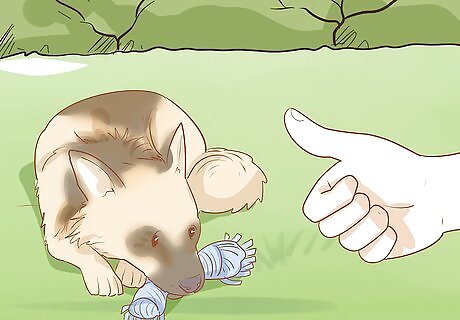
Encourage appropriate chewing. Dog toys such as balls and Kongs may appeal to your dog, just be sure to select a size that is appropriate for your dog. They should be able to pick it up and carry it but it should be of sufficient bulk that it cannot be swallowed. Praise the dog when he chooses his toy over another item that you don't want him to chew on. Do not give toys that resemble inappropriate items; for example do not give your dog an old shoe to chew on because he will not know the difference between the old chew shoe and a brand new pair.
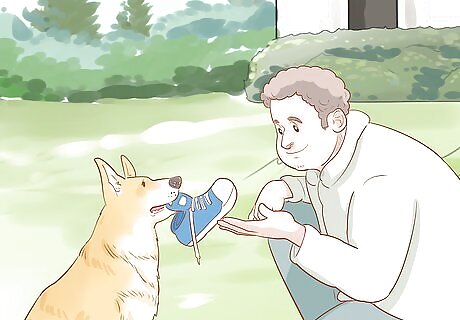
Discourage inappropriate chewing. If you do find your dog chewing on something inappropriate correct the dog by taking the object away. Direct his attentions to an appropriate chew object and give praise when he chews on said object. Gradually, your dog will learn what objects are his and which are not.
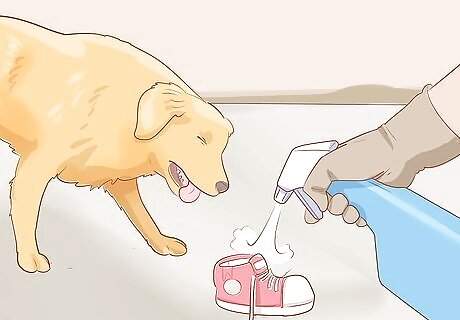
Discourage chewing inappropriate items by spraying them with chewing deterrents. When you first use a deterrent, apply a small amount to a piece of tissue or cotton wool. Gently place it directly in your dog’s mouth. Allow him to taste it and then spit it out. If your dog finds the taste unpleasant, he might shake his head, drool or retch. He won’t pick up the piece of tissue or wool again. Ideally, he will have learned the connection between the taste and the odor of the deterrent, and he’ll be more likely to avoid chewing items that smell like it. Spray the deterrent on all objects that you don’t want your dog to chew. Reapply the deterrent every day for two to four weeks. Deterrents come in many flavors and can be purchased at your neighborhood pet store. Please realize, however, that successful treatment for destructive chewing will require more than just the use of deterrents. Dogs need to learn what they can chew as well as what they can’t chew. Please see our article, Using Taste Deterrents, for more information.




















Comments
0 comment